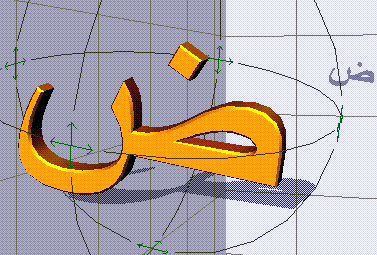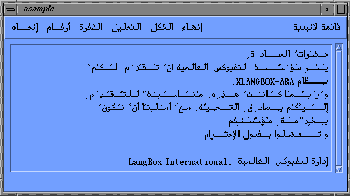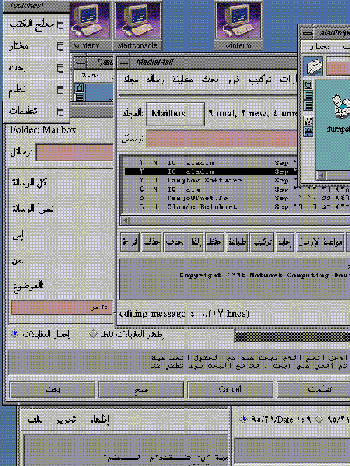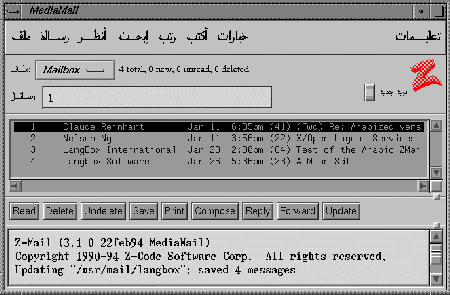
The Bilingual
Latin/Arabic Supplement
to X Window Applications
Technical
Product Description

Arabic, as a calligraphic language, presents major processing
problems.
An
Arabic character might take one, two, or sometimes four
different shapes, yet it is represented by one code. The
shape of the character is determined depending on its position
in the word. This is but one problem called "Character
Shaping".
Another
problem is the direction of writing. Arabic text is written
from right to left. This conflicts with Latin, which is
written in the opposite direction. When mixing text languages,
characters are added in one language and pushed
in the other. This is called "Bi-Directionality".
Some
users speak only Arabic. They will not accept a cursor positioned
at the leftmost position of the screen. They want to have
an option allowing them to start at the rightmost position
of the line, i.e., in brief, a mirror image of the screen.
The implication is that, in this mode, Latin characters
are pushed from right to left. This is called "Screen
Mirroring" .
Yet
one more complication is vocalization (or diacritics).
. These characters, like their counterparts in Latin, the
vowels, are a linguistic necessity. Yet, in Arabic, they
appear on top or below their respective consonants.
These
linguistic complications -- and more -- make Arabic a difficult
language to handle.
Another
aspect of the problem is that standard UNIX Operating system
support of Internationalization (local) supplies only support
for European Languages generally based on the ISO 8859-1
character codeset. This National Language Support (NLS)
allows keyboard mapping, handling of collating sequences
and character types, date and time format. It could also
include, in the near future, a specific extension for the
Japanese language, but cannot handle Arabic characters,
and, in general "right-to-left" writing direction
languages.
LangBox
International is specialized in the design and the development
of bilingual and multilingual Operating Systems. It has
implemented bilingual capabilities on a large number of
machines operating under UNIX, XENIX, AIX, SUN/OS, ISC,
SINIX, DG/UX, EP/IX, CLIX,..etc..
The
Arabization of UNIX applications can be addressed in two
main ways :
 For
"Character based" applications that run generally
on ASCII terminals (like ANSI, VT100, VT220, WYSE...), arabization
process can be achieved on the input/output character flow
of the terminal along the TTY line. The Arabic font is initially
loaded on the terminal local RAM. For
"Character based" applications that run generally
on ASCII terminals (like ANSI, VT100, VT220, WYSE...), arabization
process can be achieved on the input/output character flow
of the terminal along the TTY line. The Arabic font is initially
loaded on the terminal local RAM.
The
Transparency regarding (8 bits cleaned) applications can
be assumed. The application manages an 8 bit codeset (ISO
8859-6) and the specific Arabic processing is done by the
Operating System TTY lowest level.
LangBox
International designed and implemented "LANGBOX for
Arabic" that provides a global and transparent solution
for this kind of applications.
 With
the development of Graphical Interface (like X Window)
on Work Stations, other kinds of applications have been
designed. These applications are clients that communicate
with a Graphic Server through network connection facilities. With
the development of Graphical Interface (like X Window)
on Work Stations, other kinds of applications have been
designed. These applications are clients that communicate
with a Graphic Server through network connection facilities.
Here,
the main application routines work directly with bitmaps
and the concept of character flow has disappeared. A transparent
Arabization is more difficult to implement. We need at least
to link the application with an Arabic Graphical library,
or use an Arabic shared library at the runtime level (if
the operating system allows it). Also, some application
concepts must be implemented to allow a correct behavior.
For example, we always need to refresh the complete line
after each input character. Moreover, fonts could be selected
through a Resource file or a command line option.
Even
if all these features are present, parts of the application
could not behave correctly in Arabic (like cut and paste
for example), and, a specific implementation must be done
for the Arabic support by adding specific source code lines.
XLANGBOX
for Arabic package (called XLANGBOX-ARA) has
been defined to allow Arabization of pure X Window applications
and allows the following features:
- Providing
a global solution to Arabic and Latin simultaneously.
- Maximum
Transparency of applications.
- Total
transparency to storage and display of data in national
languages.
- Ease
of internationalization of applications.
- Conformity
with national and international standards.

This screen hardcopy shows a sample motif based application
launch under the XLANGBOX-ARA environment
| The XLANGBOX-ARA Environment |
The
XLANGBOX-ARA library package is build around the MIT X Window
and OSF MOTIF libraries. When added and linked to an application
that uses these interfaces, XLANGBOX-ARA provides the user
with a full bilingual environment in runtime application
operations.
The
XLANGBOX-ARA package is specially designed for software
developers willing to address the Arab countries' market.
With XLANGBOX-ARA, they can move a standard Latin application
with minor changes. As set of a demo and X Window samples,
OSF MOTIF and UIL program are arabized and included in the
package.
Arabization
level parameters can be selected and set at the runtime
level. These parameters could be either user independent
or in the application. They include "context analysis"
(automatic shape determination, dual keyboard state and
mapping, numeral shapes, vowels)
The
Arabic character set handled by XLANGBOX-ARA is ISO 8859-6
which is the standard adopted by the International UNIX
community.
XLANGBOX-ARA
is composed of the following parts:
- The
Arabic Context Library
- The
X Window Arabic Extension
- The
OSF MOTIF Arabic extension
- The
Arabic fonts for the server
- The
Demo Set
- The
Printing Support
These
parts can be used together or separately depending on the
need and the internal organization of the application to
be arabized.
| The Arabic Context Library (Bi-Di) |
This library contains the specific Arabic string manipulation
routines. These routines allow the following:
- "Contextation"
of ISO 8859-6 strings coming from a storage area, and
makes it readable according to the Arabic context (generally
for a display purpose).
- Character
position calculation: These routines allow to locate the
new position value for a character after or before a contextation.
- Attribute
range selection: These routines allow to calculate a new
attribute range of a string after or before a contextation.
- "Contextation"
parameter management: These routines allow to get or to
set the specific Arabic parameter used during the "context
analysis" of strings. These parameters are mainly
the following:
Arabic
Dual Keyboard management - Key Layout customization for
engraved keyboards.
Arabic
Data codeset filtering (such as for MS CP1256 codeset).
This
library is an independent library. It can be used for any
application that wants to handle directly Arabic strings.
| The X Window Arabic Extension
|
This library contains arabized X11 routines for string manipulation.
These routines are the following:
For
string display purposes:
- XDrawString(
)
- XDraw../imagestring(
)
- XDrawText(
)
For keyboard management
For Font loading management
- XloadFont()
- XLoadQueryFont()
In order to be used, this library must be added to the link
phase and be referenced before the standard X11 one (-lX11)
on the command line or for Runtime only configuration, the
LD_LIBRARY_PATH environment variable should be set to the
XLANGBOX-ARA directory.
| The OSF Motif Arabic Extension
|
This library contains Arabic complement routines to the famous
Open Software Foundation "MOTIF Library". This complement
allows the handling of the following primitive MOTIF widgets:
- XmText
- XmTextField
- XmString
All
other widget types benefit of this arabization (like list,
file selection box, push button, menu, etc.).
In
order to be used, this library must be added to the link
phase and be referenced before the standard (-lXm) on the
ld command line or for Runtime only configuration, the LD_LIBRARY_PATH
environment variable should be set to the XLANGBOX-ARA directory
.
| The Arabic Fonts for the X Server |
XLANGBOX-ARA supply a set of Arabic
fonts for the X server running on the target machine.
These fonts are in "snf" format and also in "bdf"
format for heterogeneous network connections. Several sizes
are available and can be selected either from the application
itself or from a resource file.
XLANGBOX-ARA
contains fixed spacing fonts and proportional spacing fonts
that gives better looking results for Arabic.
The
listing of the fonts is the following :
ara0814_96.bdf: ara0814_96
ara0814t96.bdf: ara0814t96
ara0915_96.bdf: ara0915_96
ara0920_96.bdf: ara0920_96
ara1230_96.bdf: ara1230_96
ara0915p96.bdf: ara0915p96
naskhiBf08.bdf: -lbi-naskhi-bold-r-normal--8-80-75-75-m-50-iso8859-6
naskhiBf10.bdf: -lbi-naskhi-bold-r-normal--10-100-75-75-m-60-iso8859-6
naskhiBf12.bdf: -lbi-naskhi-bold-r-normal--12-120-75-75-m-70-iso8859-6
naskhiBf14.bdf: -lbi-naskhi-bold-r-normal--14-140-75-75-m-90-iso8859-6
naskhiBf18.bdf: -lbi-naskhi-bold-r-normal--18-180-75-75-m-110-iso8859-6
naskhiBf24.bdf: -lbi-naskhi-bold-r-normal--24-240-75-75-m-150-iso8859-6
naskhiRf08.bdf: -lbi-naskhi-medium-r-normal--8-80-75-75-m-50-iso8859-6
naskhiRf10.bdf: -lbi-naskhi-medium-r-normal--10-100-75-75-m-60-iso8859-6
naskhiRf12.bdf: -lbi-naskhi-medium-r-normal--12-120-75-75-m-70-iso8859-6
naskhiRf14.bdf: -lbi-naskhi-medium-r-normal--14-140-75-75-m-90-iso8859-6
naskhiRf18.bdf: -lbi-naskhi-medium-r-normal--18-180-75-75-m-110-iso8859-6
naskhiRf24.bdf: -lbi-naskhi-medium-r-normal--24-240-75-75-m-150-iso8859-6
naskhiRp08.bdf: -lbi-naskhi-medium-r-normal--8-80-100-100-p-12-iso8859-6
naskhiRp10.bdf: -lbi-naskhi-medium-r-normal--10-100-100-100-p-15-iso8859-6
naskhiRp12.bdf: -lbi-naskhi-medium-r-normal--12-120-100-100-p-18-iso8859-6
naskhiRp14.bdf: -lbi-naskhi-medium-r-normal--14-140-100-100-p-21-iso8859-6
naskhiRp18.bdf: -lbi-naskhi-medium-r-normal--18-180-100-100-p-28-iso8859-6
naskhiRp24.bdf: -lbi-naskhi-medium-r-normal--24-240-100-100-p-36-iso8859-6
naskhiOp12.bdf: -lbi-naskhi-medium-o-normal--12-120-75-75-p-64-iso8859-6
naskhiOp24.bdf: -lbi-naskhi-medium-o-normal--24-240-75-75-p-126-iso8859-6
naskhiOp10.bdf: -lbi-naskhi-medium-o-normal--10-100-75-75-p-54-iso8859-6
naskhiOp34.bdf: -lbi-naskhi-medium-o-normal--34-340-75-75-p-177-iso8859-6
naskhiOp20.bdf: -lbi-naskhi-medium-o-normal--20-200-75-75-p-105-iso8859-6
naskhiOp14.bdf: -lbi-naskhi-medium-o-normal--14-140-75-75-p-75-iso8859-6
naskhiBp12.bdf: -lbi-naskhi-bold-r-normal--12-120-75-75-p-63-iso8859-6
naskhiBp24.bdf: -lbi-naskhi-bold-r-normal--24-240-75-75-p-123-iso8859-6
naskhiBp10.bdf: -lbi-naskhi-bold-r-normal--10-100-75-75-p-53-iso8859-6
naskhiBp34.bdf: -lbi-naskhi-bold-r-normal--34-340-75-75-p-172-iso8859-6
naskhiBp20.bdf: -lbi-naskhi-bold-r-normal--20-200-75-75-p-102-iso8859-6
naskhiBp16.bdf: -lbi-naskhi-bold-r-normal--16-160-75-75-p-84-iso8859-6
naskhiBp14.bdf: -lbi-naskhi-bold-r-normal--14-140-75-75-p-73-iso8859-6
This set is given for X11/MOTIF developers. It allows to understand
how arabization can be included in an existing application.
This demo set includes samples for:
- Sample
character based program
- Pure
X Window (X11) interfaced program
- OSF/MOTIF
interfaced application
- OSF/MOTIF
and UIL build applications
Several
Arabic software developer's recommendations are also included.
This sub package consists in a set of printer fonts that are
downloaded directly on the supported printer, using specific
XLANGBOX-ARA commands.
It
also includes a new specific line printer spooler that must
be used instead of the standard lp or lpr ones,
for printing Arabic files. Postscript printing is also supported
using the aa2ps filter tool.
| The XLANGBOX-ARA Standard Aspect |
XLANGBOX-ARA
is adapted to the standards as set forth by AT&T's SVID,
X Window System and ISO.
The
standards adopted under XLANGBOX for Arabic are
related to the following:
- Character
sets.
- Standard
display conventions.
- Arabic
level support standards.
The Arabic characters are 8-bits wide and conform to the
following standard :
Characters
will be displayed according to their language specific conventions.
Latin characters will always appear separately, while Arabic
characters will be contexted and displayed in their composite
form.
The
display technique adopted depends on the base and current
languages chosen by the user.
When
the environment is Latin, the initial cursor position is
at the left of the line and characters are added to the
right as they are entered. Arabic characters are inserted,
and pushed to the right as they are entered.
When
the environment is Arabic, the reverse phenomenon occurs:
the initial cursor position is at the right most position
of the line, Arabic characters are added and Latin's are
inserted. Vocalization is fully supported on terminals capable
of displaying 256 downloadable characters.
These
characters are not context sensitive and do not, therefore,
affect the shape of Arabic characters. Yet they have, in
certain instances, opposite meaning in Arabic, due to the
direction in which this language is written. Typical examples
are: ( ) { } < > [ ] ...
A
special command handles the meaning the user wants to assign
to these special characters.
The user is provided with a command allowing the display
of numerals in Latin (Arabic shapes) or Arabic (Hindi Shapes).
All known complications associated with this subject have
been solved and incorporated in the package.
| Automatic Shape Determination
(Shaping) |
The standard rule is to display characters in the way calligraphy
requires it. It was, however, found that this feature should
be optional, since system users are frequently in debug work
sessions and prefer to have their characters displayed in
their original, base form. A pair of routines has been included
to inhibit or restore Automatic Shape Determination.
This
process is also called "context analysis".
XLANGBOX manage a logical
dual keyboard. A keystroke allows to switch from one to
the other (generally the <ctrl T>). Arabic layout is
indicated by transparent keyboard
stickers that the user disposes on his Latin Keyboard.
French/Arabic layout
is also available.
The
system's compose key or pressing both Alt key simultaneously
can also be used.
Sample
SGI IndigoMagic Desktop launched with XLANGBOX-ARA

| XLANGBOX-ARA Level Support Standards |
The
XLANGBOX-ARA working environment uses these environment
variables:
| Variable
name |
Value |
Description |
AR_DIRECTION
|
latin
| arabic
|
set
the display direction |
| AR_CONTEXT |
on
| off |
enable
disable auto shape determination |
| AR_TASHKIL |
on
| off |
enable
disable Arabic tashkil |
| AR_HINDI |
on
| off |
enable
disable Hindi numerals |
| AR_DATA_PROC |
on
| off |
enable
disable DataProc mode |
| AR_NEUTRAL |
"string" |
define
the neutral character list |
| AR_KBDLANG
|
latin
| Arabic |
set
the initial keyboard language |
| AR_KBDTOGGLEKEY |
code |
set
the keyboard toggle key code |
| AR_KBDMAPFILE |
filename |
set
the keyboard file mapping |
| AR_FORCEFONTNAME |
on
| off |
activate
the dynamic font name mapping |
| AR_DEFAULTFONTNAME |
fontname |
define
the default font for dynamic mapping |
| AR_FONTSET |
"string" |
Define
the Arabic fontset used |
| AR_FONTMAPFILE |
filename |
define
the output font mapping |
| AR_CODESET |
codeset |
define
the data input codeset for conversion |
| Using Dynamic Linked Libraries
with XLANGBOX-ARA |
This
section tries to explain how we can use existing applications
that use shared libraries, and specially X Window or/and
Motif libraries .
Such
an executable program will load its X Window or/and Motif
routines at the runtime phase, using a runtime linker. If
we substitute the regular X Window or/and Motif libraries
of the system with the Arabized ones, then the used program
will be able to manage Arabic data without any modifications.
This is a very important feature that allows to run any
existing English applications with Arabic data and without
any change to its binary code. This feature is called "Transparency".
However,
all X Window or/and Motif applications will not behave correctly
in Arabic at 100 per cent, and some specific parts of the
application may not be covered by the Motif or the X Window
Arabization. All display that don't use the Motif or the
X Window set of routines, but some proprietary routines
and/or fonts. We could find these cases on GIS map design
routines for example.
In
order to replace regular dynamic linked libraries with the
Arabized ones we could use the environment variable LD_LIBRARY_PATH.
This variable allows to define the search path for shared
objects at the run time.
XLANGBOX-ARA 2.0 is available on the following operating
systems/environments:
- SUN
Solaris 2.3, 2.4, 2.5.1, 2.6, 7 and 8 for SPARC series
/ OpenWindow or CDE
- SUN
Solaris X86 2.6 (beta only)
CDC's
EP/IX / RISC Window
- SGI's
IRIX 5.3 and 6.2 / X Window and Indigo Magic
- DEC
UNIX (OSF1) 3.2 on Alpha / CDE
XLANGBOX-ARA 2.0 is available on the following target
machines :
- PC/AT
Architecture on the Intel 80386 and 80486 platform
- Sun's
SPARC series
- Control
Data's Mips series.\
- Silicon
Graphics INDY, INDIGO, CHALENGE and ONYX Series.
- DEC
AlphaStation
XLANGBOX-ARA 2.0 provides full support for the following
printer or compatible printer:
- IBM
4201 us (9 pin)
- IBM
4201 (9 pin)
- Epson
lq1000 (24 pin)
- Fujitsu
dl3400 (24 pin)
- HP
deskjet 500+
- HP
laserjet (PCL)
- DEC
LA75+
- Postscript
Standard
ZMail Motif based application dynamically linked with XLANGBOX-ARA
Motif library

Note:
This document includes some terms such as UNIX, X Window, OSF
Motif, Postscript, IndigoMagic, Zmail, VT100, VT220, WYSE… that
are trademarks or Copyrights from their respective authors.
LANGBOX-ARA
is a trademark of LangBox International
UNIX
is a trademark of AT&T
MOTIF
is a trademark of OPEN SOFTWARE FOUNDATION
|